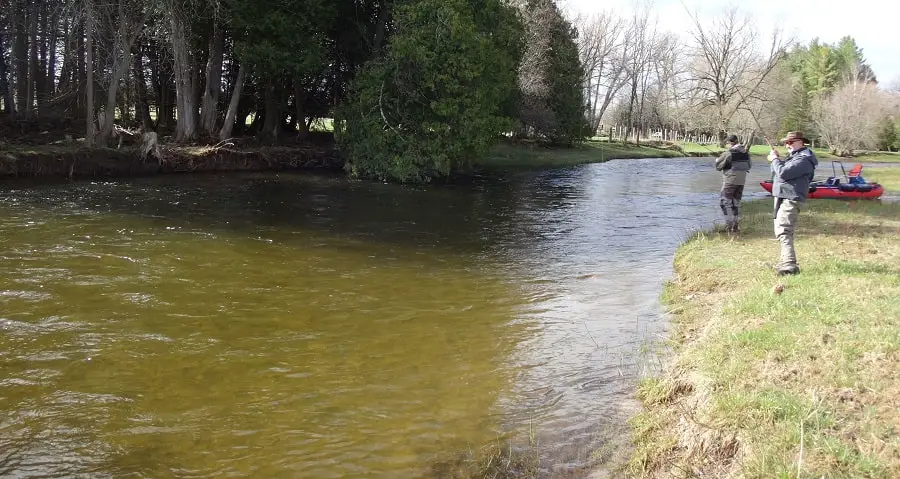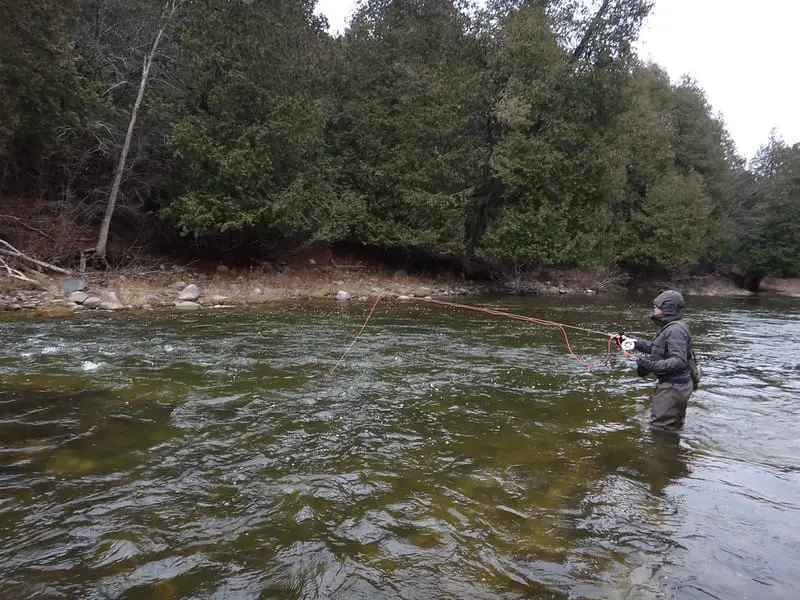Fly Fishing Ohio Steelhead: Advice And Tips From Guides

I’ve been a fly fishing guide for Great Lakes steelhead for over 22 years. Fly fishing for Ohio steelhead can be broken down into five simple steps, which I will cover in this article.
This article discusses everything about fly fishing Ohio steelhead with tips, methods, and tactics, all coming from river guides.
Fly Fishing Ohio Steelhead
The rivers are generally shallow with plenty of pools, riffles, and pocket water, which can all be fished effectively with a few select fly fishing methods. On top of that, steelhead love flies.
The Ohio steelhead fishery was created and is maintained by the ODNR through extensive stocking programs, with reports of initial stockings of over 500,000 steelhead a year.
Select rivers, such as the Grand River, the Chagrin River, Conneaut Creek, Rocky River, and Vermilion River, enjoy annual stockings, making them the best rivers for fly fishing steelhead in Ohio.
For more information on these Ohio Rivers, check out my page on Best Ohio Steelhead Rivers.
Best Times To Fly Fish Ohio Steelhead
Steelhead migrate from Lake Erie into the many rivers to spawn.
This upriver migration kickstarts from late September to late May; however, the peak times begin Mid-to-late October to mid-December in Fall and then again from mid-March until early May in Spring.
Numerous triggers make the steelhead start to run the rivers. These include rain, water levels, wind, and time of year.
Anglers who know how to predict the runs and who can be on the river fishing when the steelhead are moving through will do very well.
Ohio Rains And Water Levels.

One of the key factors of when the steelhead will enter the rivers, aside from the time of year, is water levels.
Heavy rains in September and October will start the fall steelhead runs, and more runs will continue into December after each rain.
In the spring, snowmelt, warming river water temperatures, and spring rains can trigger large runs of steelhead.
But with big rains and snow melt comes high and dirty water, and with dirty water, the steelhead can not see the flies. This means anglers must wait one to five days before the rivers clear enough to fish.
The good thing with Ohio is that there are small to very large creeks ranging from under 20 feet wide to rivers over 70 feet wide, and they rise and clear at different times.
So, while my favorite larger rivers, like the Grand River, might be high and muddy and will take five days to become fishable, a smaller creek or river nearby might be clear within 24 hours after a rain.
Fly anglers should learn about these rivers and how to fish each of them as the waters start to clear after the heavy rains. See Steelhead Run Ohio: Guide Tips For Timing The Runs.

Knowing how to fish the rivers during fall, winter, and spring is equally important.
This also includes what flies to use, when to be on the water, and how to stay warm and comfortable.
See these articles:
Types of Fly Fishing
Fly fishing can be done using various methods like nymph fishing, euro-style nymphing, Spey fishing, and streamer fishing.
Knowing which method to use, having an effective setup, as well as using the right flies are important for the success of any steelhead fly fishing trip.
Indicator Nymphing

Nymphing for steelhead is a very effective way to catch steelhead and likely the most productive fly fishing method.
This fly fishing method involves suspending a fly below the surface in a way that naturally imitates the food source of steelhead. This can be done using what is called an indicator.
Indicator Nymphing is effective in sections of the river that are 3 feet to 12 feet deep, with the best water between 4 to 6 feet deep.
There are a lot of strike indicators on the market that will not just help detect a bite from a fish, but improve my presentation and help me and my clients catch more fish. Using the right type of indicator is important, even for a guy like me who has been indicator fishing for over 30 years.
Personally, I recommend indicators such as RAVEN FS Indicator Floats, THILL Indicators, and New Zealand Wool Strike Indicators. However, I have an in-depth page on the best indicators for different types of river conditions. Check out my page on What Are The Best Indicators For Fly Fishing? Guides Advice.
Remember, for most fly anglers, indicator nymphing is the most productive method, but ONLY if they do it correctly. If you are new to indicator fishing or want to know how the guides do it, check out my page, Nymphing For Steelhead.
Best Flies For Ohio Steelhead

We are lucky to have Gareth Thomas as one of our contributing Ohio river guides.
Gareth, who runs Alley Grabs Guide Service in Ohio, says the best flies for Ohio steelhead are natural-colored fly patterns when the rivers are clear and bright colors when the rivers are off-colored.
Some of Gareth’s favorites include yellow, white, and peach colored egg patterns, stonefly and mayfly nymphs, as well as white Zonker minnows.
Most standard steelhead nymphs can work well for this fly fishing style, including worm patterns, flashy egg patterns, and woolly buggers.

Other great flies include Hare’s Ear, Caddis Larva, The Copper John, and The San Juan Worm.
For more on flies for Great Lakes steelhead, See 19 Best Steelhead Flies.
Euro Nymphing

Euro nymphing, also known as Modern Nymphing, is a relatively new way of fly fishing for steelhead in Ohio and around the Great Lakes region.
In my area, I believe I was the first guide to offer and use Euro Nymphing methods for steelhead.
I started perfecting this method somewhere around 2006, before most anglers had even heard of it.
Euro nymphing originated from European competition anglers for trout, and if I were a competition angler and didn’t use these Euro Nymphing methods, I could not compete.
These European anglers are still known to be the best fly anglers in the world, or at least incredibly hard to beat.
The great thing is that most Ohio steelhead rivers are perfect for Euro nymphing.
Using this method for steelhead requires some minor adjustments to the traditional nymphing in order to compensate for the larger steelhead size and the larger tributary size.
Euro Nymphing excels in pocket water and shallower water under 5 feet deep. In place of an indicator, strike detection is via a “sighter,” which is a colored piece of line 3 to 6 feet up the leader.
Euro nymphing enables a slow and natural presentation of the fly, particularly at the speed of the bottom current, thus giving a more natural drift, which allows the steelhead to detect the flies better.
Euro nymphing also allows for better strike detection, thanks to having a tight line through the entire drift.
Euro nymphing rig typically consists of a longer rod, and a very long leader with a built-in sighter, weighted flies, and no split shot.
The weighted flies allow me to quickly get my flies into the strike zone and keep them there.
Again, flies are weighted according to the water conditions. Get more information on my page on Euro Nymphing For Steelhead: Methods And Tips Of The Guides.
Best Flies For Euro Nymphing

There are a number of nymphs that will do the trick for this style of fishing. Some of my favorites include the Tungsten Bead Head Prince Nymph, the Frenchie, the Tungsten Jig Fly, the Polish Pheasant Tail Nymph, and the Hot Tag Pheasant Tail Nymph.
Most good nymphs used for trout will also work for steelhead. For more euro nymphing flies for steelhead that I like and use, check out The Fly Fiend nymphs.
Streamer Fishing For Steelhead

Streamer fishing for steelhead is another very effective and fun way to fish for steelhead in Ohio Rivers because the rivers are easy for casting and are not too deep.
This method of fly fishing uses a submerged fly known as a streamer. Streamers are built to imitate large baitfish or small fish that usually fall prey to large fish such as minnows, sculpin, and emerald shiners.
Since streamer fishing involves casting and retrieving to imitate swimming baitfish, it is a great way of covering a large amount of water in a smaller time frame and can be effective for catching big steelhead.
It is important to be meticulous about picking the right streamer color based on the river conditions. This will depend on the color of the water or the amount of sunlight available.
As a rule of thumb, I use lighter streamers for sunnier days, and black or purple streamers for darker days.
While the dark background will outline the streamer’s silhouette, the lighter background will reflect the rays of the sun.
Best Flies for Streamer Fishing
A hot guide streamer fly is the white Zonker fly, however the Zonker, in Olive, or black can be very effective.
When it comes down to selecting the appropriate flies, there are a number of options available. Top streamer options include Wooley Bugger, Flash Fry, Sculpzilla, Mini Loop Sculpin, and the Wooley Sculpin.
I use streamer fishing methods adapted to fishing for steelhead. See Streamer Fishing For Steelhead.
Spey Fly Fishing For Ohio Steelhead

Spey fishing for steelhead, also known as swinging flies, involves casting a Spey fly across the river using a Spey line and Spey rod and allowing it to swing.
This fly fishing method is effective when fishing large rivers for steelhead.
Spey fishing is best fished with a double-handed fly rod, often referred to as a Spey rod. This Spey technique allows for more powerful and long-distance casts with little to no backcast room required.
Spey casting also employs fairly short and heavy lines known as Skagit lines, and are designed to cast big flies in big sections of rivers. These Skagit lines are heavy and make it possible for anglers to easily throw heavy sinking tips a long way.
Both Scandi lines and Skagit lines are suitable for Ohio rivers.
For more detailed information on how to do this well, as well as methods for spring, fall, and winter steehead Spey fishing, and the best rods and reels, see: Spey Fishing For Steelhead: Best Setup And Tactics For Great Lakes
Best Flies For Spey Fishing
The right flies are essential for having a good experience while spey fishing. Ultimately, flies for steelhead spey fishing should be effective at imitating baitfish and designed to trigger the aggressive predator instinct of steelhead.
Top Spey flies options include Sparkle Soft Hackle, Gold-Ribbed Hare’s Ear Wet, Tungston head Soft Hackle Pheasant Tail, Bead Head Soft Hackle Caddis Pupa, and Hornberg Wet.
Keep in mind that different times of the year will have different hot flies, and as an expert on Spey fishing in Ohio, Gareth knows which flies are best. Check out his series on Spey fishing for his favorite techniques and flies throughout the season.
- Fall Spey Fishing
- Winter Spey Fishing For Steelhead: Tips And Tactics Used By Guides
- Converting Finicky Steelhead On The Spey
Tight Lines,
Graham

